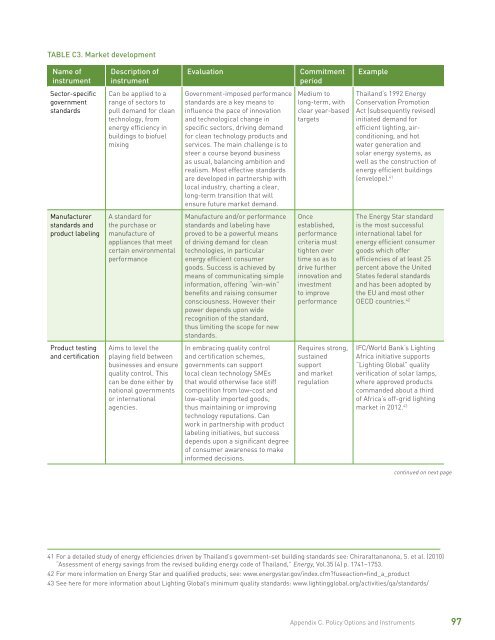Building Competitive Green Industries
green-industries
green-industries
You also want an ePaper? Increase the reach of your titles
YUMPU automatically turns print PDFs into web optimized ePapers that Google loves.
TABLE C3. Market developmentName ofinstrumentDescription ofinstrumentEvaluationCommitmentperiodExampleSector-specificgovernmentstandardsCan be applied to arange of sectors topull demand for cleantechnology, fromenergy efficiency inbuildings to biofuelmixingGovernment-imposed performancestandards are a key means toinfluence the pace of innovationand technological change inspecific sectors, driving demandfor clean technology products andservices. The main challenge is tosteer a course beyond businessas usual, balancing ambition andrealism. Most effective standardsare developed in partnership withlocal industry, charting a clear,long-term transition that willensure future market demand.Medium tolong-term, withclear year-basedtargetsThailand‘s 1992 EnergyConservation PromotionAct (subsequently revised)initiated demand forefficient lighting, airconditioning,and hotwater generation andsolar energy systems, aswell as the construction ofenergy efficient buildings(envelope). 41Manufacturerstandards andproduct labelingA standard forthe purchase ormanufacture ofappliances that meetcertain environmentalperformanceManufacture and/or performancestandards and labeling haveproved to be a powerful meansof driving demand for cleantechnologies, in particularenergy efficient consumergoods. Success is achieved bymeans of communicating simpleinformation, offering “win-win”benefits and raising consumerconsciousness. However theirpower depends upon widerecognition of the standard,thus limiting the scope for newstandards.Onceestablished,performancecriteria musttighten overtime so as todrive furtherinnovation andinvestmentto improveperformanceThe Energy Star standardis the most successfulinternational label forenergy efficient consumergoods which offerefficiencies of at least 25percent above the UnitedStates federal standardsand has been adopted bythe EU and most otherOECD countries. 42Product testingand certificationAims to level theplaying field betweenbusinesses and ensurequality control. Thiscan be done either bynational governmentsor internationalagencies.In embracing quality controland certification schemes,governments can supportlocal clean technology SMEsthat would otherwise face stiffcompetition from low-cost andlow-quality imported goods,thus maintaining or improvingtechnology reputations. Canwork in partnership with productlabeling initiatives, but successdepends upon a significant degreeof consumer awareness to makeinformed decisions.Requires strong,sustainedsupportand marketregulationIFC/World Bank‘s LightingAfrica initiative supports“Lighting Global” qualityverification of solar lamps,where approved productscommanded about a thirdof Africa’s off-grid lightingmarket in 2012. 43continued on next page41 For a detailed study of energy efficiencies driven by Thailand’s government-set building standards see: Chirarattananona, S. et al. (2010)“Assessment of energy savings from the revised building energy code of Thailand,” Energy, Vol.35 (4) p. 1741–1753.42 For more information on Energy Star and qualified products, see: www.energystar.gov/index.cfm?fuseaction=find_a_product43 See here for more information about Lighting Global’s minimum quality standards: www.lightingglobal.org/activities/qa/standards/Appendix C. Policy Options and Instruments97


